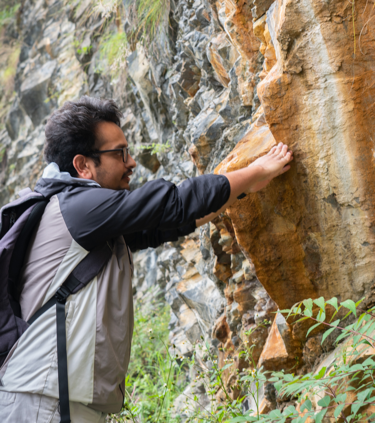Geophysical and Geo-AI based Evaluation and Modelling of Earthquake Induced Landslides
Ashok Dahal is a PhD student in the Department of Applied Earth Sciences. (Co)Promotors are prof.dr. C.J. van Westen, prof.dr. M. van der Meijde and dr. L. Lombardo from the Faculty ITC.
 Approximately 3% of the Earth's landmass is highly vulnerable to landslides, with many of these areas being inhabited or utilized due to limited land resources. This situation puts human populations and infrastructure at considerable risk. Annually, landslides result in an average of 4,600 fatalities, nearly half of the 7,600 deaths attributed to flooding. As a result, landslides, alongside earthquakes and floods, rank among the deadliest natural hazards in mountainous regions. Although landslides often occur on a localized scale, their impact on populations and infrastructure can be more severe than that of other hazards, such as fluvial floods, making them disproportionately harmful to human lives and built environments. Specifically, Earthquake-induced landslides (EQIL) pose significant risks to life and infrastructure during seismic events. Understanding how ground motion influences landslides is critical to mitigate these risks. However, this relationship remains underexplored due to the scarcity of spatially detailed ground motion data and comprehensive landslide inventories. This limitation makes it challenging to develop robust frameworks for accurately predicting EQIL.
Approximately 3% of the Earth's landmass is highly vulnerable to landslides, with many of these areas being inhabited or utilized due to limited land resources. This situation puts human populations and infrastructure at considerable risk. Annually, landslides result in an average of 4,600 fatalities, nearly half of the 7,600 deaths attributed to flooding. As a result, landslides, alongside earthquakes and floods, rank among the deadliest natural hazards in mountainous regions. Although landslides often occur on a localized scale, their impact on populations and infrastructure can be more severe than that of other hazards, such as fluvial floods, making them disproportionately harmful to human lives and built environments. Specifically, Earthquake-induced landslides (EQIL) pose significant risks to life and infrastructure during seismic events. Understanding how ground motion influences landslides is critical to mitigate these risks. However, this relationship remains underexplored due to the scarcity of spatially detailed ground motion data and comprehensive landslide inventories. This limitation makes it challenging to develop robust frameworks for accurately predicting EQIL.
To understand and model the effect of ground motion on landslide occurrence (especially for data-scarce regions), we have simulated the full waveform data for each landslide initiation location and validated these waveforms with seismic and remote sensing approaches. Once the detailed ground motion is generated, we use that data together with geophysical and environmental variables to answer questions such as how various ground motion intensities can influence landslide occurrence, how the surface topography plays a role in the spatial distribution of landslides and how we can model such landslide occurrence efficiently in both deterministic and probabilistic scenarios (using highly nonlinear models, such as deep learning).
As a result of such questions, we have found that traditional ground motion intensity parameters often are not good enough to estimate landslides, and the combination of multiple intensity parameters is much better. We also found that the topographic amplification of seismic waveform plays a more significant role in the genesis of landslides on the far field for mega earthquakes. Moreover, we developed explainable deep learning modelling frameworks for landslides, which can estimate landslide location, size, and frequency given the seismic and geophysical conditions in deterministic and probabilistic scenarios. For the first time, we have combined a full waveform dataset with a data-driven modelling framework and developed steps towards physics-informed neural networks for regional-scale landslide hazard modelling.



